|
1’32”
|
“Prediction markets… It’s about people with skin in the game that are speculating on outcomes”
Tomaino is an early NFT investor and founder of cryptocurrency-focused fund 1confirmation, self-described as “a venture fund that supports exceptional founders fueling the decentralization of the web and society.” It was individually backed by people like Peter Thiel and Marc Andreessen.
In the same interview Tomaino confidently holds that “markets are fundamentally a better source of truth than media or narratives.” https://blockworks.co/podcast/empire/ac184194-301d-11ee-8b52-27c8e47f9ddb
|
|
2’26”
|
“Artist, writer and filmmaker Bahar Noorizadeh”
Information about Bahar Noorizadeh and her work can be found at her website https://baharnoorizadeh.com/
|
|
3’23”
|
“The Red City of the Planet of Capitalism”
Originally conceived as a two-screen installation, The Red City of the Planet of Capitalism was originally commissioned by 2038, the German Pavilion at the Venice Architecture Biennial 2021.
The stand-alone video is focused on the fictional or ideal (or, in today’s vocabulary, speculative) proposition by representatives of the Russian architectural avant-garde of the 1920s that cities be dissolved into networks, and more specifically a sort of revolutionary sprawl across the whole Soviet Union.
The film “relies on analysis, dissection, and recombination, and entails several levels of images and sounds. The virtual world is accompanied by idiosyncratic music, historical and fictional narratives, quotes from which stand in fragments and in bold block letters in the countryside.”
Red City of Planet Capitalism is available at https://vimeo.com/540346330

Museum Folkwang, photo by Michael Paul Romstöck (2021)
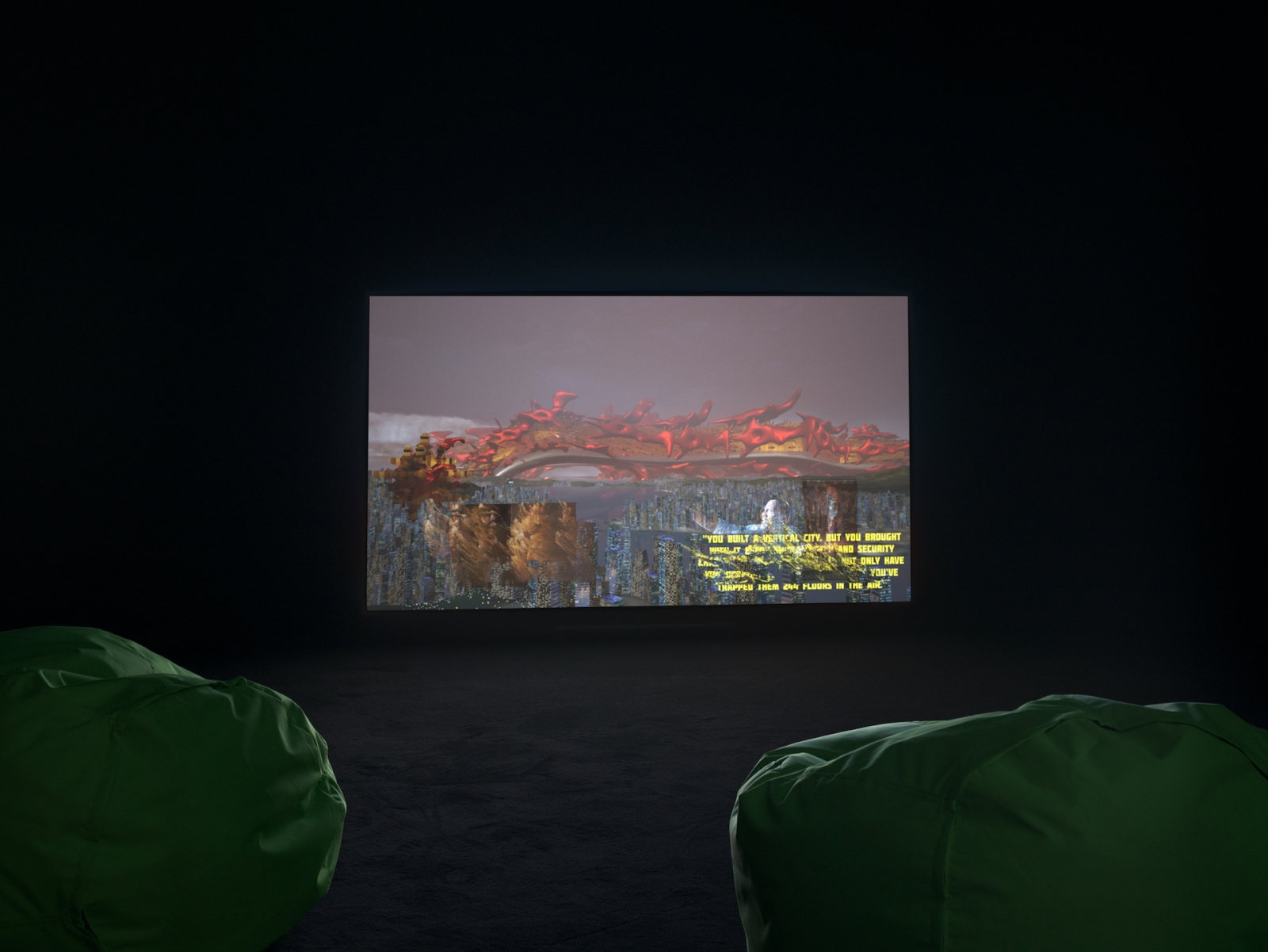
Installation view at Museum Folkwang, Essen (2021)
|
|
3’40”
|
“In a letter to Le Corbusier…”
Avant-garde urban planner Moisei Ginzburg had a few letter exchanges with architect Le Corbusier in 1929-30. In one of them, later published in the Sovremennaia Arkhitektura journal (1930), Ginzburg said:
“You are the finest of the surgeons of the modern city, you want to cure it of its ills whatever the cost. Therefore you raise the entire city on stilts, hoping to solve the insoluble urban traffic problem. You create wonderful gardens on the roofs of tall buildings, hoping to give people an extra patch of green, you design homes whose occupants enjoy perfect convenience, peace, and comfort. But you do all this because you want to cure the city, because you are trying to keep it essentially the same as capitalism made it.
We in the USSR are in a more favorable position — we are not tied by the past.
History confronts us with problems that can only have a revolutionary solution [paraphrasing Marx] and, however feeble our resources, we will solve them no matter what.
We are making a diagnosis of the modern city. We say: yes, it is sick, mortally sick. But we do not want to cure it. We prefer to destroy it and intend to begin work on a new form of human settlement that will be free of internal contradictions and might be called socialist.”
(Source: https://thecharnelhouse.org/2010/10/02/ginzburg%E2%80%99s-reply-to-le-corbusier-on-deurbanization/ )
|
|
5’20”
|
“Histories of network design that come before cybernetics…”
“Beginning in the decade before World War II and accelerating through the war and after, scientists designed increasingly sophisticated mechanical and electrical systems that acted as if they had a purpose. This work intersected other work on cognition in animals as well as early work on computing. What emerged was a new way of looking at systems—not just mechanical and electrical systems, but also biological and social systems: a unifying theory of systems and their relation to their environment. This turn toward ‘whole systems’ and ‘systems thinking’ became known as cybernetics.”
This brief introduction to cybernetics is taken from How cybernetics connects computing, counterculture, and design by Hugh Dubberly and Paul Pangaro (Originally published by the Walker Art Center in the catalog for the exhibition Hippie Modernism: The Struggle for Utopia.) https://staging.dubberly.com/cybernetics/article-inside-text/
Monoskop offers a wide and reasoned selection of books and essays about cybernetics, its genealogy in the United States, France, the Soviet Union, and Germany in the 1940s and 1950s, the so-called second-order cybernetics, and the impact of the broad field of cybernetics in various sciences, including humanities, social sciences and culture: https://monoskop.org/Cybernetics
|
|
6’00”
|
“If you really want to have a communist society, you need to get rid of the city ”
In the first issue of Sovremennaia Arkhitektura (1930) Barsch and Ginzburg literally wrote:
“This system must be contrasted by the socialist system of prophylaxis, the system of the elimination of the city, with all its specific attributes, promoting a settlement sodality of man able to solve the problems of work, of rest, of his culture, as a whole and uninterrupted process of socialist being.”
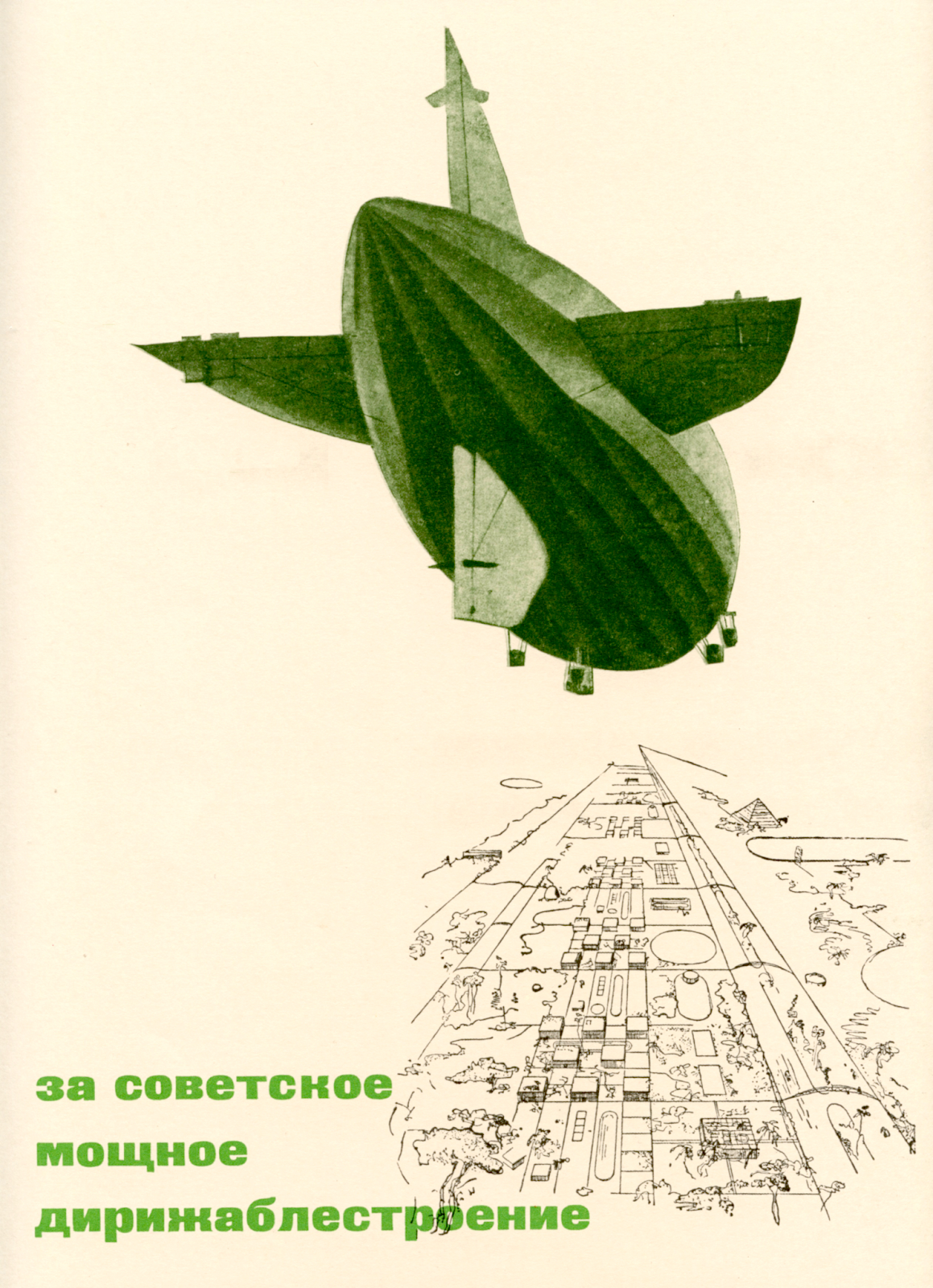
Cover of Sovremennaia Arkhitektura (1930)
The ambitious vision of a post-city society proposed by disurbanists in the Green City contest, although concrete, never materialized and the government dismissed their ideas as economically risky utopian experiments.
While the Soviet Union abided by classical urbanism, constructing hyper-centralist cities with grand boulevards and mass-produced towers, similar to contemporary designs, one of the disurbanists, Mikhail Okhitovich, was the first architect who was sent to the camps at the very start of the Great Terror.
Sources:
https://honisoit.com/2021/03/notes-on-disurbanism/
http://www.recentering-periphery.org/disurbanism/
|
|
8’15”
|
“170 km long, 500m tall and only 200m wide…”
The commercial description of The Line can be found on the website of their promoters as one of the “regions” they are developing: https://www.neom.com/en-us/regions/theline
|
|
9’15”
|
“It’s Anthropoforming by way of Terraforming”
The conventional notion of ‘terraforming’ describes “the hypothetical process of deliberately modifying the atmosphere, temperature, surface topography or ecology of a planet, moon, or other body to be similar to the environment of Earth to make it habitable for humans to live on” (Wikipedia). Its roots can be found in both science fiction, and scholarly physics and astronomy.
However, our reference here is a different take on the same notion as applied to planet Earth itself. The notion of ‘geoengineering’ already covers part of this concept when it refers to large scale interventions such as climate or geological engineering. Adopting the term terraforming, instead, suggests a partial displacement: it’s not just engineering, it’s not “just” Planet Earth as an object or raw material.
This notion of terraforming suggests that Planet Earth should be looked at, instead, as the result of older designs that might even look uncanny or alien to us now. Hence, contemporary terraforming implies awareness of scale, consequences, and the complexity of interactions that make Planet Earth possible in the present and, more importantly, in the future.
Probably the most consistent and articulated approach to these issues has been provided by philosopher Benjamin Bratton in his book The Terraforming (Strelka Press, 2019): “The title refers both to the terraforming that has taken place in recent centuries in the form of urbanization, and to the terraforming that must now be planned and conducted as the planetary design initiative of the next centuries. The term ‘terraforming’ usually refers to transforming the ecosystems of other planets or moons to make them capable of supporting Earth-like life, but the looming ecological consequences of what is called the Anthropocene suggest that in the decades to come, we will need to terraform Earth if it is to remain a viable host for its own life.”
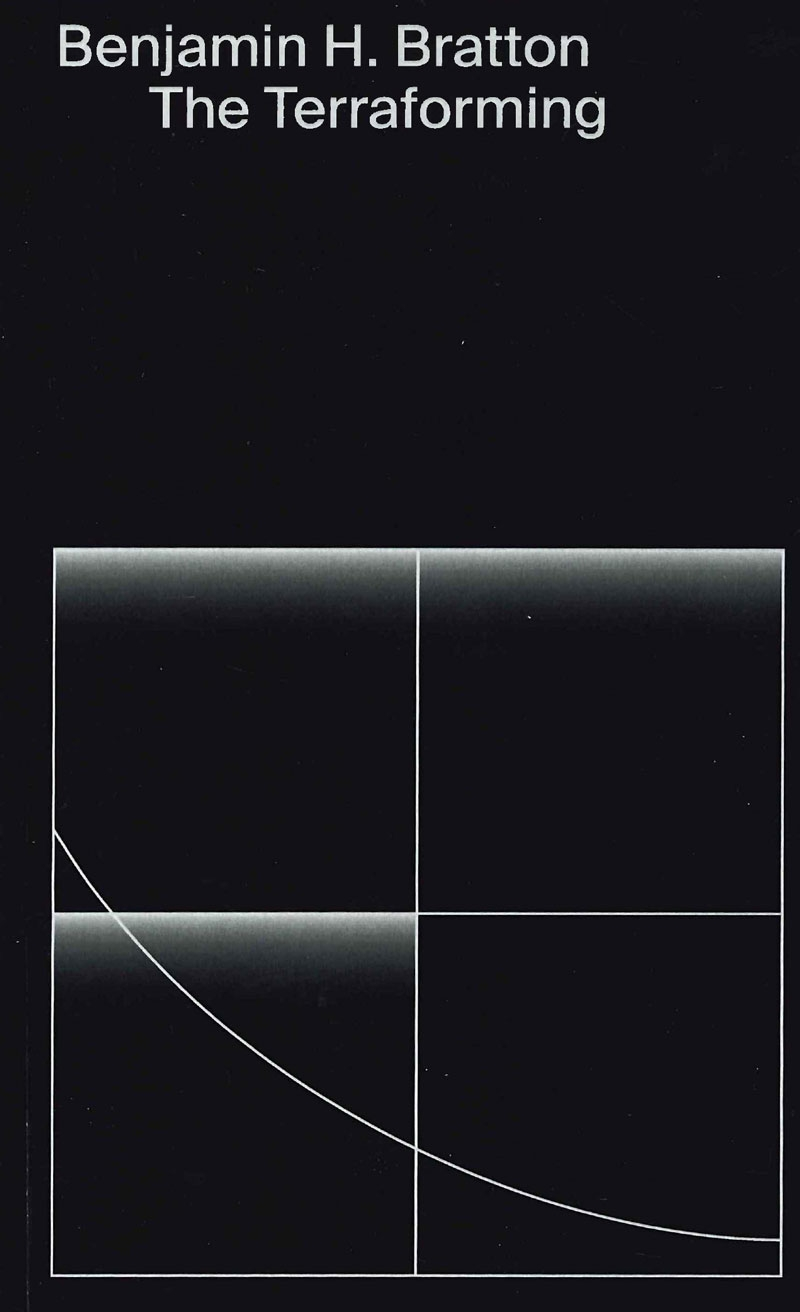
|
|
11’10”
|
“The popular press called the computers, the machines of communism…”
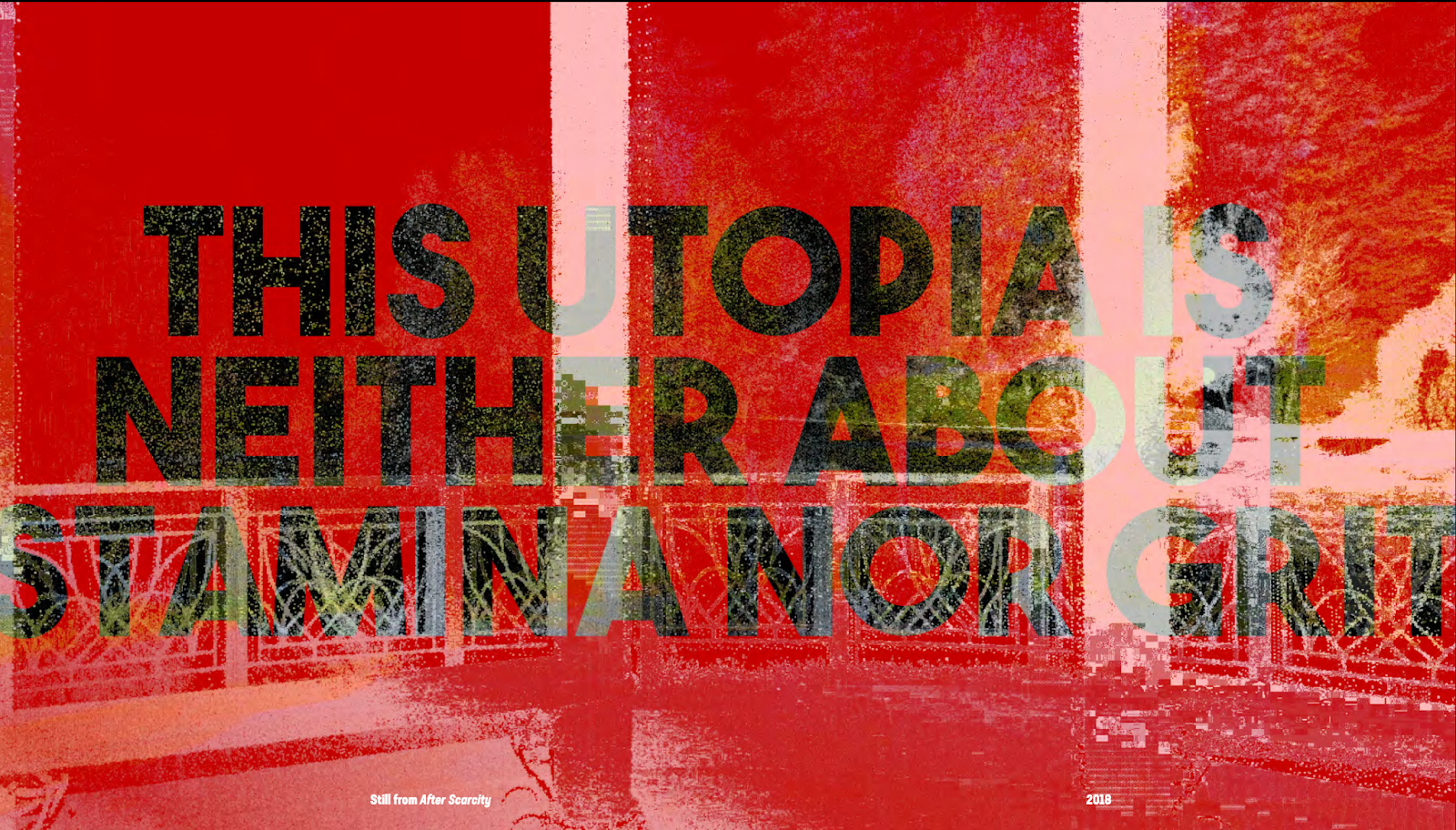
Still from After Scarcity by Bahar Noorizadeh
From the introduction to After Scarcity, a 2018 film by Bahar Noorizadeh:
“In the Soviet Union of the 1960s, some technologists saw computers as machines of communism and cybernetics as an answer to the difficulties of a waning centrally planned economy. After Scarcity is a sci-fi video-essay that tracks these Soviet cyberneticians in their attempt to build a fully-automated planned economy. If history at its best is a blueprint for science-fiction, revisiting contingent histories of economic technology might enable an access to the future.
“How might we use computation to get us out of our current state of digital feudalism and towards new possible utopias? Flying through swarms of floating dots outlining monasteries and city streets, After Scarcity flashes through decades of history to propose the ways contingent pasts can make fictive futures realer, showing us that digital socialism was inbred into the communist revolution and that computation doesn’t mean we’re condemned to today’s tyranny of total financialization.”
The film is available at https://vimeo.com/296563987
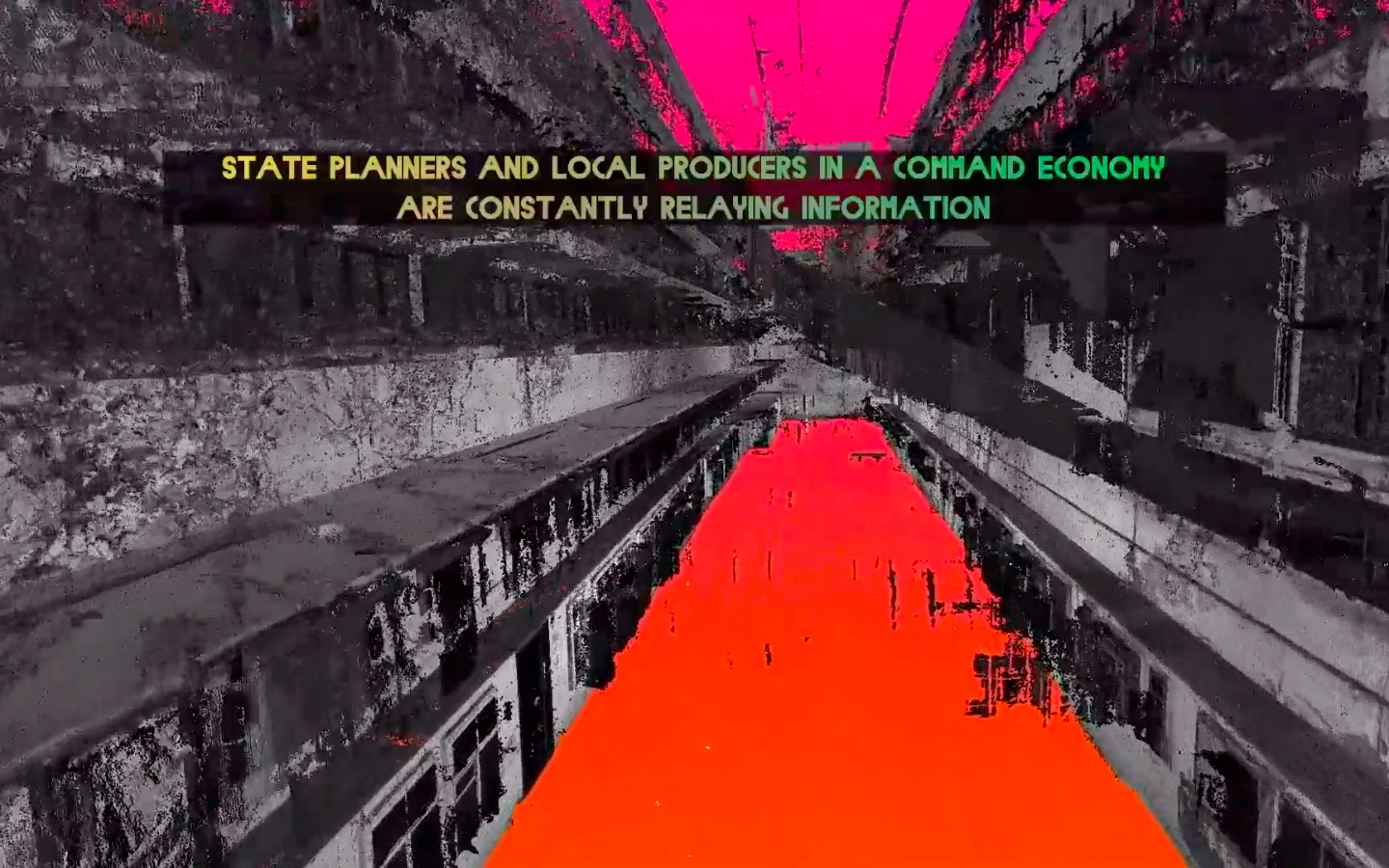
Still from After Scarcity by Bahar Noorizadeh
|
|
11’30”
|
“Cybernetic pasts, financial futures: the calculation of the unknown”
“It was the combination of war and revolution, the wreckage of World War I in Europe, and the practicalities of running a worker-owned state with the epic size of Russia, that made scale synonymous with imagination. Particularly in the field of economics, a transition to efficiency sciences— management, logistics, planning—was in order as early as the communist revolution took place. Economics at this time advanced into the science of building the most accurate scale model—let’s call it an algorithm—for the biophysical reality of nation-wide production and distribution. [Text highlighted by the podcast author]
[...]
“The first attack on optimized planning was launched by Ludwig von Mises, the Austrian school economist largely influential for the emergence of neoliberal doctrine. Von Mises was adamant about the impossibility of a socialist system to lead to anything but failure, because rational calculation of a large-scale economy was, rationally speaking, impossible. The amount of information that had to be collected, stored, processed, analyzed, and circulated at every fraction of a second by the centralized planners was simply unachievable. In contrast, the market, with the mysterious sophistication of a black box, did not require any such laborious information technology. This argument, visited time and again as the most fervent economic dispute of the twentieth century, was labeled the Socialist Calculation controversy.” [Text highlighted by the podcast author]
Quotes from “Cybernetic pasts, financial futures: the calculation of the unknown” by Bahar Noorizadeh, in Bassam El Baroni (Ed.), Between the Material and the Possible - Infrastructural Re-examination and Speculation in Art (Sternberg, 2021)
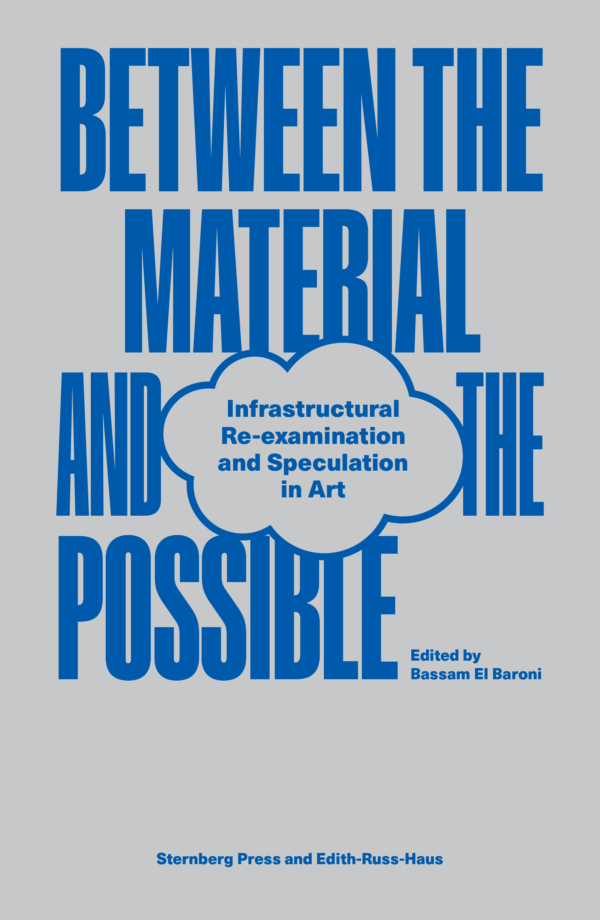
|
|
13’41”
|
“Minor histories of computation…”
Norbert Wiener and cybernetics, as well as project Arpanet, have become canonical milestones in the history of digital technologies and networks, along with their well documented impact on society in the second half of the 20th century.
However, in the last few years books and essays contributed to popularize other “minor” histories of networks and computation, most notably in Soviet Russia and in Chile under the short-lived Allende’s government in the early 1970s.
On OGAS and Soviet attempts to build a “unified information network”, see Benjamin Peters’s How Not to Network a Nation (MIT Press, 2016).

On Proyecto Cybersyn in Chile under Allende, see Eden Medina’s book Cybernetic Revolutionaries: Technology and Politics in Allende’s Chile (MIT Press, 2011).

On the same topic, we also recommend The Santiago Boys, a gripping podcast with an amazing background research by writer and technologist Evgeny Morozov (2023).

|
|
15’09”
|
“The derivative notion of the future or expectations was always embedded in any form of exchange”
The notion of financial markets as essentially future-oriented devices has been at the core of financial institutions and financial instruments in capitalist societies since the inception of the market of so-called ‘futures’ in Chicago in the mid 20th century.
However, authors like anthropologist Benjamin Lee and the late cultural theorist Randy Martin suggested that derivative finance has more profound social and cultural dimensions, dating back to pre-modern societies and gift economies. This approach allows to “look past the usual arguments for the regulation or abolition of derivative finance, [and] ask a more probing question: what kinds of social institutions and policies would we need to put in place to both avail ourselves of the derivative’s wealth production and make sure that production benefits all of us?” (from the presentation of Derivatives and the Wealth of Societies - University of Chicago Press, 2016)

|
|
15’33”
|
“The challenge that Hayek posed…”
For the early neoclassical economists like Friederich Hayek (at least in the first stages of his intellectual production) the market works as a powerful, intelligent technology, too complex to be steered by any government:
“It is more than a metaphor to describe the price system as a kind of machinery for registering change, or a system of telecommunications which enables individual producers to watch merely the movement of a few pointers, as an engineer might watch the hands of a few dials in order to adjust their activities to changes of which they may never know more than is reflected in the price movement.” (F. Hayek, Individualism and Economic Order, Regnery, 1948).
In the aforementioned essay, Bahar Noorizadeh comments on Hayek’s words:
“The market for early neoliberalism was a computer, and price was not only one of its properties but the measure of change in society at large, the ledger capturing the archive of humanity-as-civilization. In such an atmosphere, it is not difficult to imagine what the arrival of computers meant for the buzz around mathematization of economics in the West, and its strange kinship with planned variants in the East.” (B. Noorizadeh, “Cybernetic pasts, financial futures: the calculation of the unknown” by Bahar Noorizadeh, in Bassam El Baroni (Ed.), Between the Material and the Possible - Infrastructural Re-examination and Speculation in Art (Sternberg, 2021)
|
|
17’33”
|
Free to Choose

Bahar Noorizadeh’s Free to Choose is an “operatic financial sci-fi” film. Set in different Hong-Kongs across time and narrated by the US neoliberal economist and economic guru Milton Friedman, the story revolves around a credit banking system that mutated into a time traveling machine:
“In 1997, in post economic crash Hong Kong, Philip Tose, ex-race car driver and CEO of an insolvent company travels to the future to borrow a lump sum from his older self and rescue his business. Hong Kong in 2047 turns out not to be very different from the Hong Kong of ‘One Country, Two systems’. Centralisation has not eradicated nepotism, and activism has become rating activism: young people advocating for free time travel for everyone, including the untrustworthy and the discredited of a corrupt credit system. In the background is superstar economist and real-life evangelist Milton Friedman’s myth of neoliberalism as represented by Hong Kong: In his long career as a market ideologue and advisor to the conservative governments of the US and the UK, Friedman hailed the city as the modern exemplar of free markets, needless of heavy- handed government planning and control. “If you want to see Capitalism in action, you should go to Hong Kong.”
For a narrative-theoretical account of this film (which can be considered a spin-off of the former After Scarcity), see this piece by Bahar Noorizadeh: https://www.e-flux.com/architecture/cascades/391412/the-red-city-of-the-planet-of-capitalism/


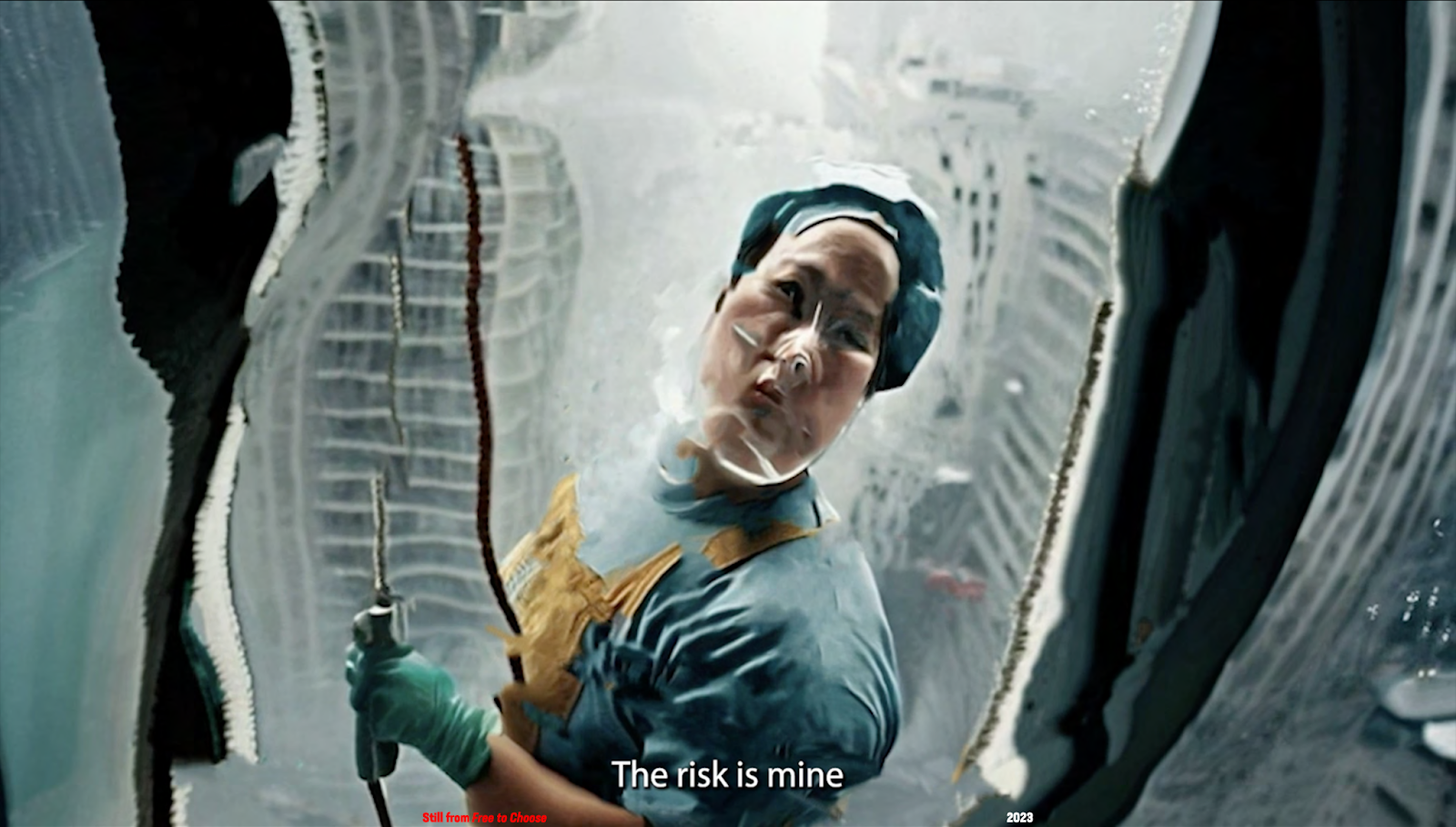
Stills from Bahar Noorizadeh’s Free to Choose (2023)
|
|
17’42”
|
“If you wanna see how a free market really works…”
Hong Kong tended to become a very prominent node in a global financial network as it was consciously designed by the ruling British colonial government in the late 20th century as a financialized city and a turbo-real estate phenomenon.

Speaking directly to the camera, with a panoramic view of Hong Kong’s harbor in the background, Friedman declares: “if you want to see how the free market really works, this is the place to come.”
This is an excerpt of episode 1 “The Power of the Market” of a 1980 TV series called - guess what - Free to Choose. Today it is widely reproduced online as some sort of viral, often out-of-context manifesto of what extreme neoliberal and radical free-market policies should be.
|
|
20’04”
|
(In Chinese) “Hong Kong’s wormhole was marked by these fifty-year intervals”
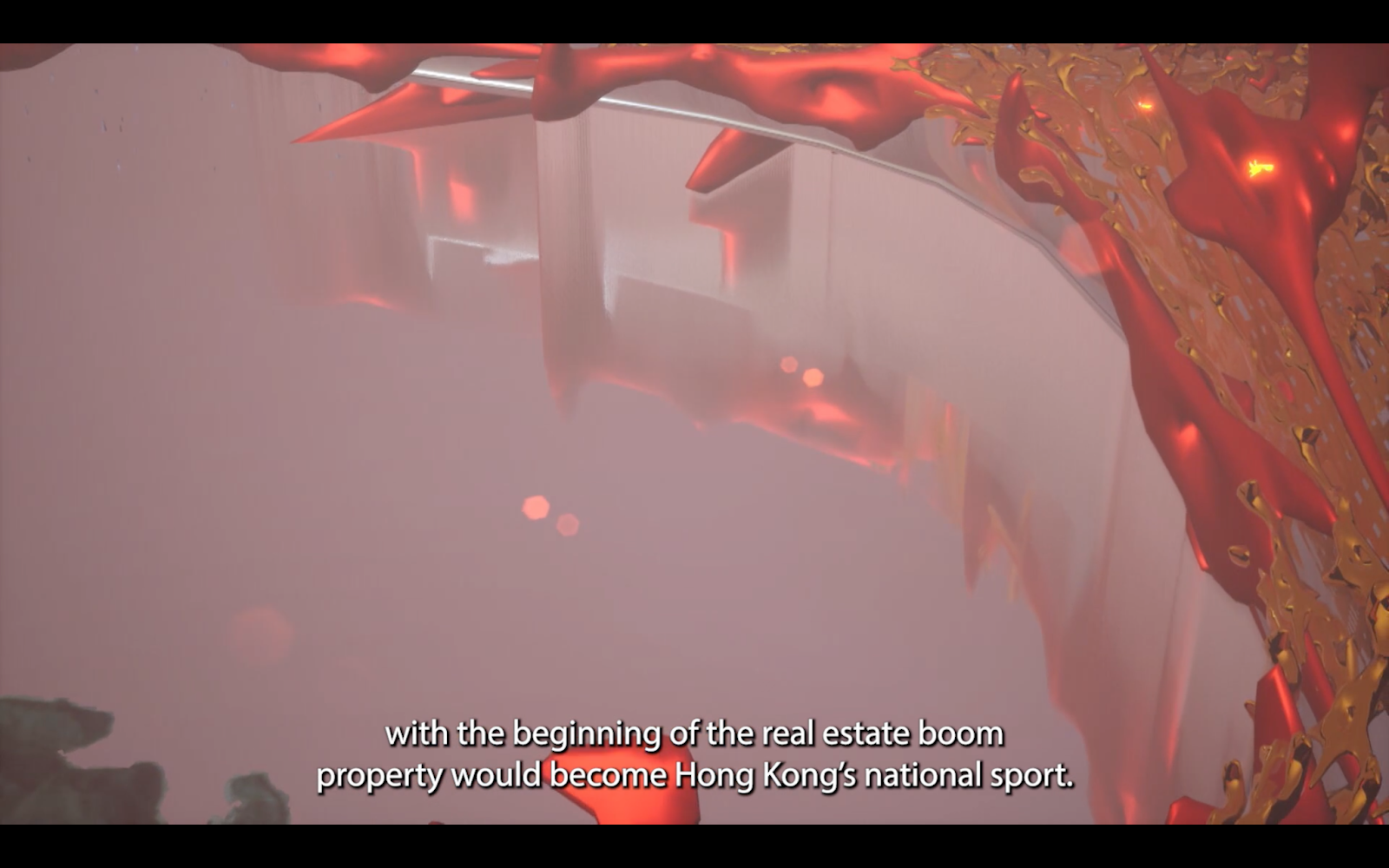
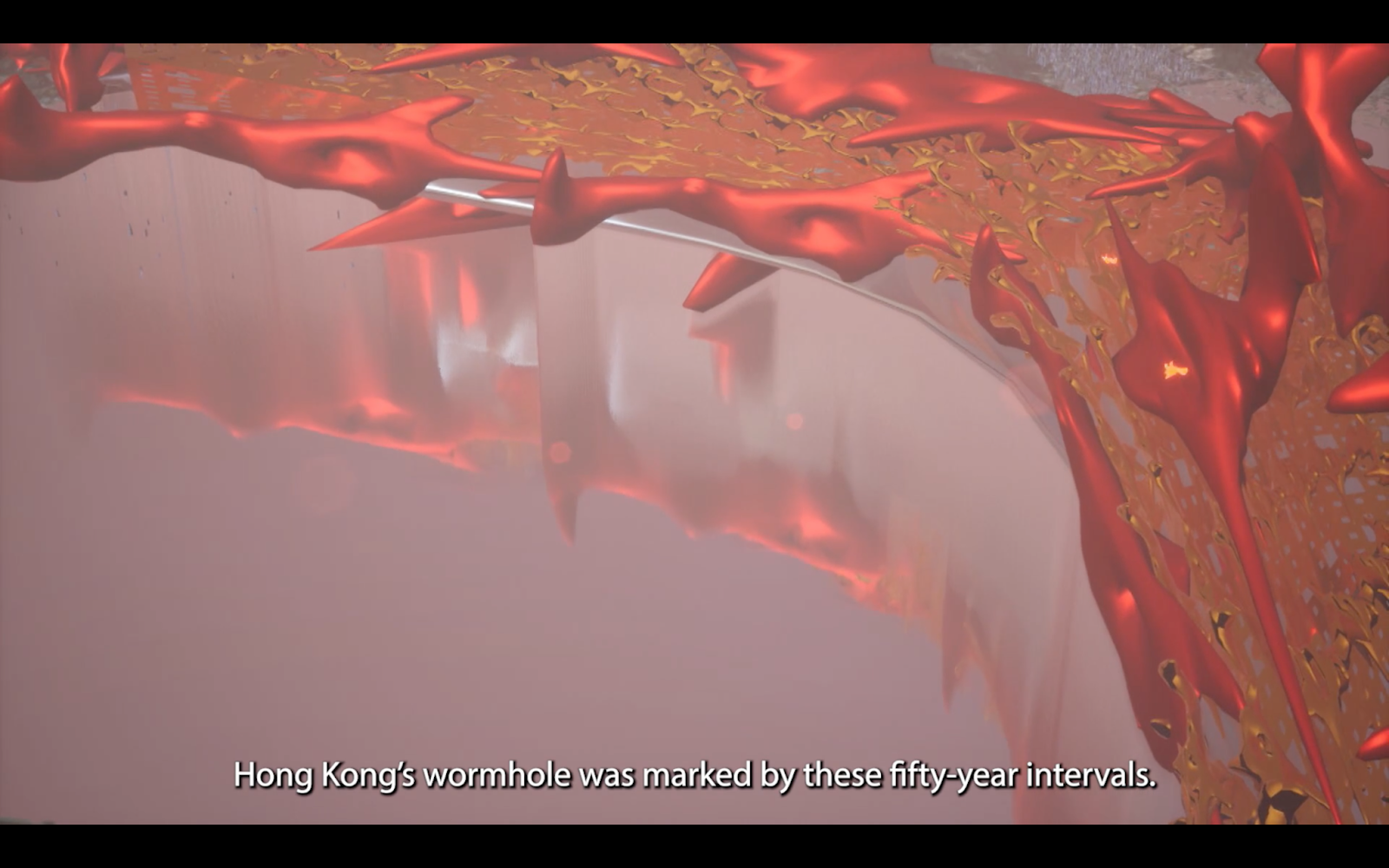

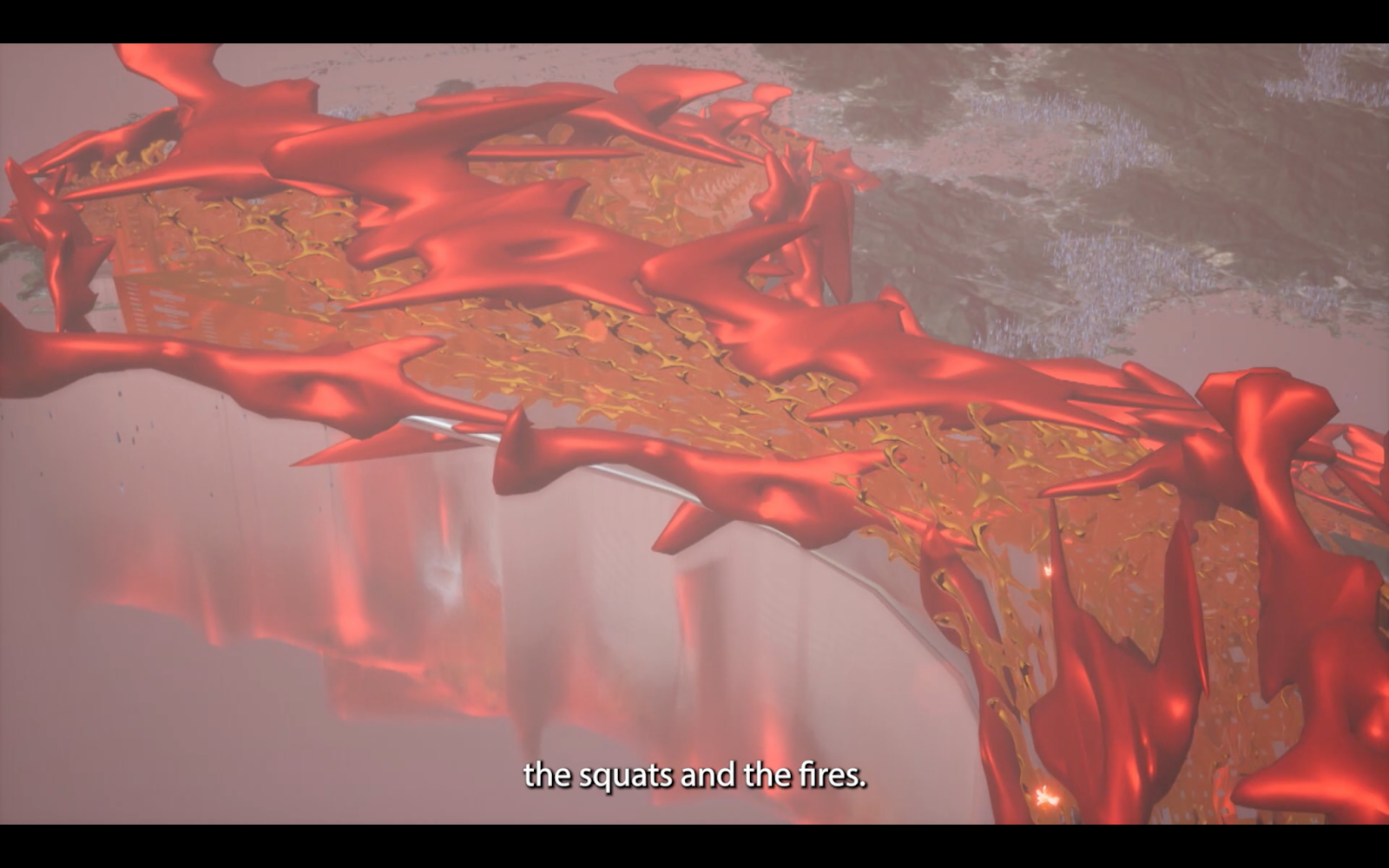
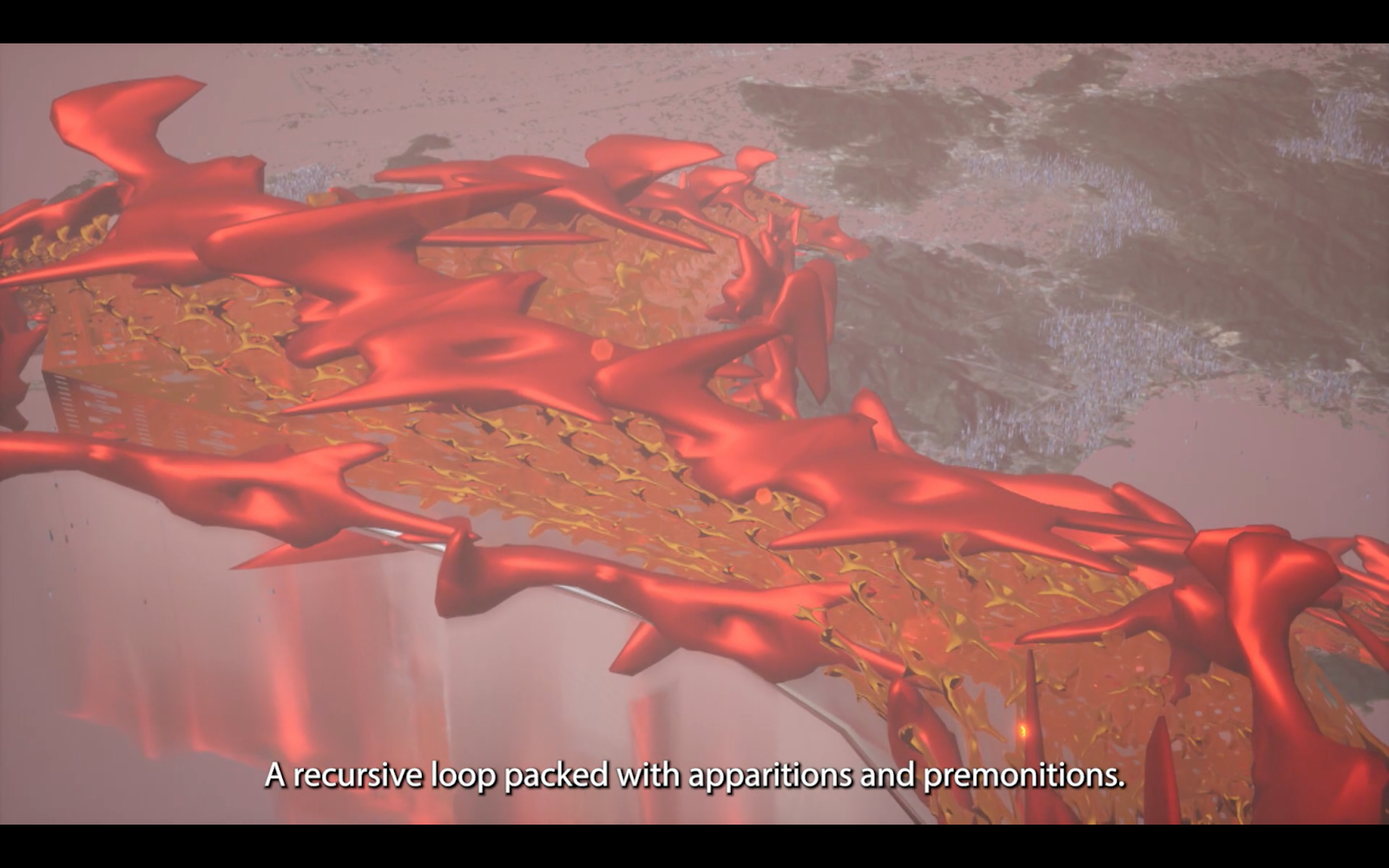
Stills from Free to Choose
While a voice recaps in a few evocative seconds a hundred years in the history of Hong Kong, on screen we catch a glimpse of the fictional Pearl Megalopolis, “the largest social housing estate extended across the Pearl River mega-city, providing affordable housing to citizens from Guangzhou to Shenzhen, to Hong Kong and Macau”, a “continent-wide spider in the sky”. (Quotes from Bahar Noorizadeh on e-flux)
|
|
21’37”
|
“Almost a century after the post-war growth and the massive immigrations…”
Here are just a few, basic visual cues for the multiple colonial histories of Hong Kong.

Hong Kong, by Mark Kauffman, LIFE March 1947

Drought in Hong Kong, 1963

The Hong Kong Riots of 1967
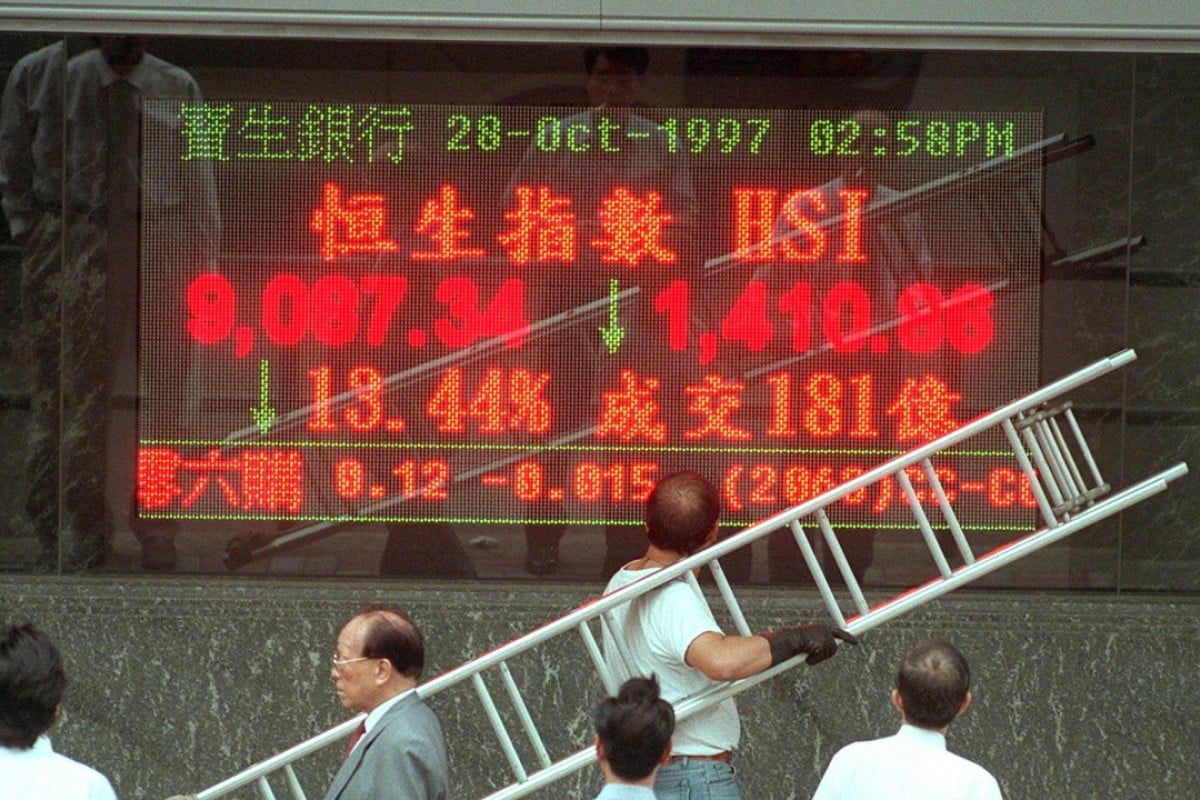
The 1997 financial crash (South China Morning Post - Photo by Martin Chan)
|
|
23’30”
|
“In the book that he wrote to his daughter…”
Reference to Yanis Varoufakis, Talking to My Daughter About the Economy or, How Capitalism Works—And how it fails (Penguin, 2017).
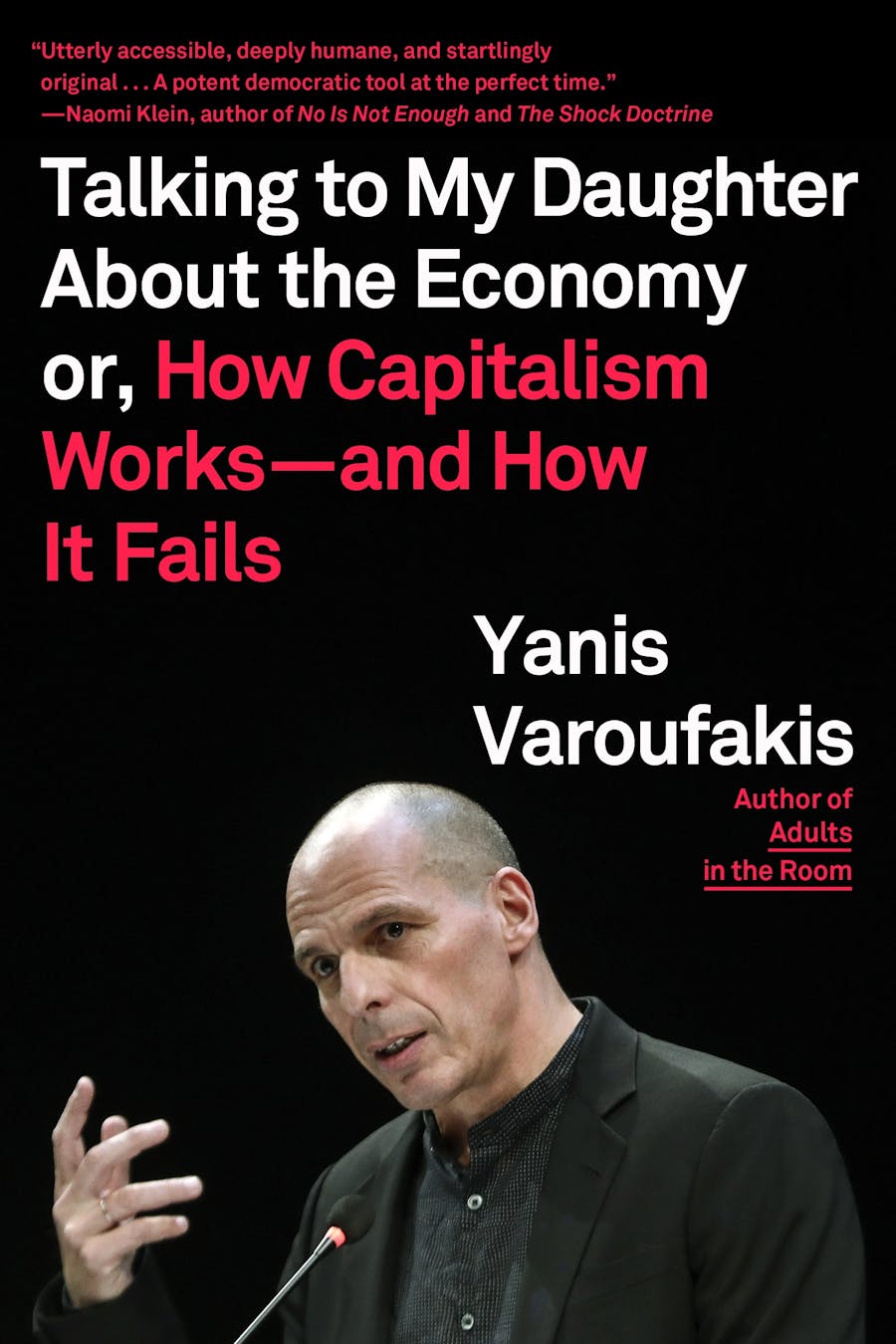
|
|
24’11”
|
“Practices based on reckless betting and information asymmetry”
A very extreme case of information asymmetry can be found in the so-called high-frequency trading, explained by journalist Michael Lewis in Flash Boys (2014), one of the earliest accounts of the phenomenon.
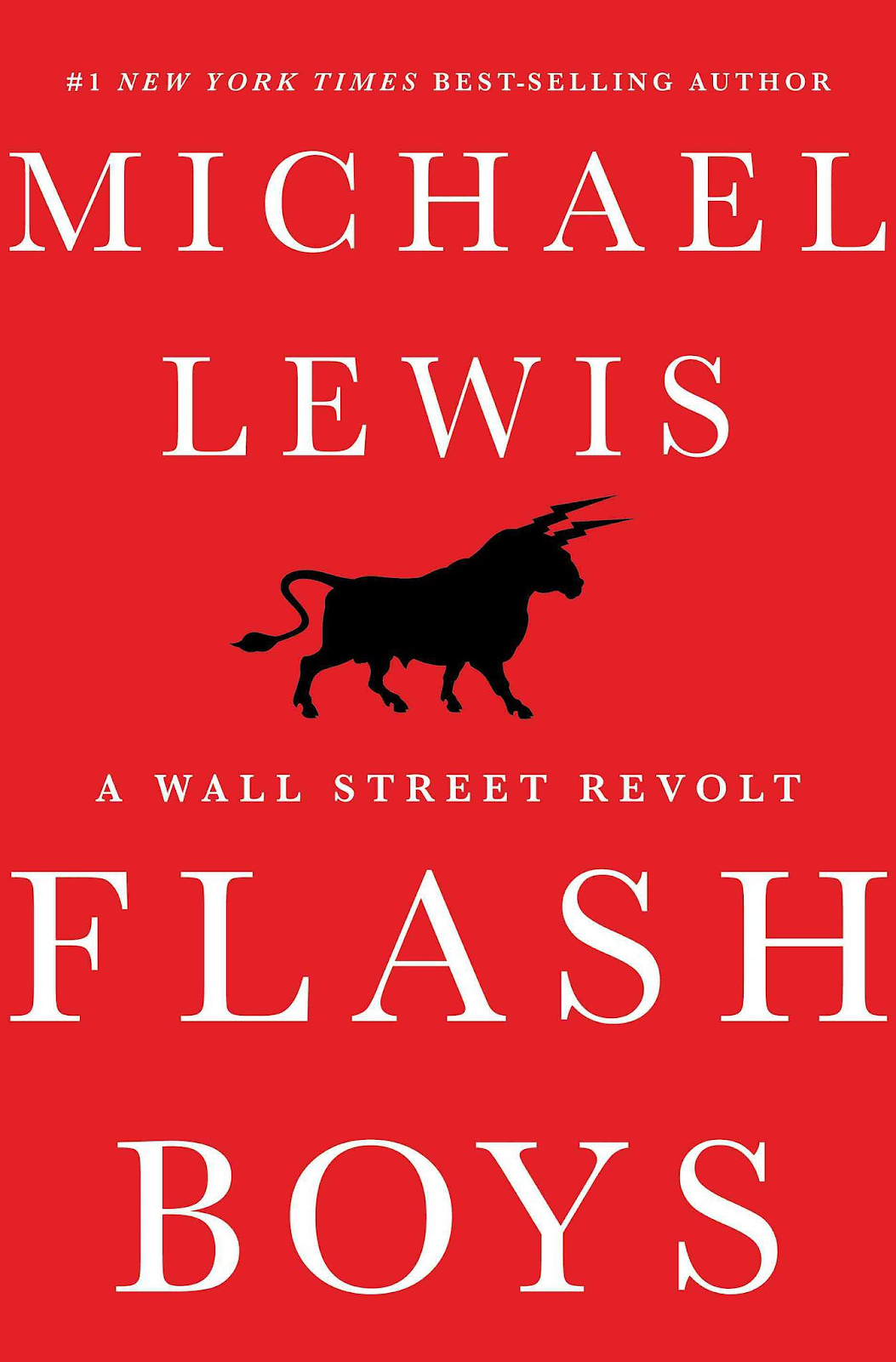
For a different approach on high-frequency trading and information asymmetry in finance, here is a sequence of artists Sylvia Eckermann’s and Gerald Nestler’s project The Future of Demonstration (2018), featuring “I’m a Specialist”, a performative lecture by automated finance expert and whistleblower Haim Bodek based on one of his successful whistleblower cases that resulted in a record-setting penalty for US-based exchanges for regulatory violations.
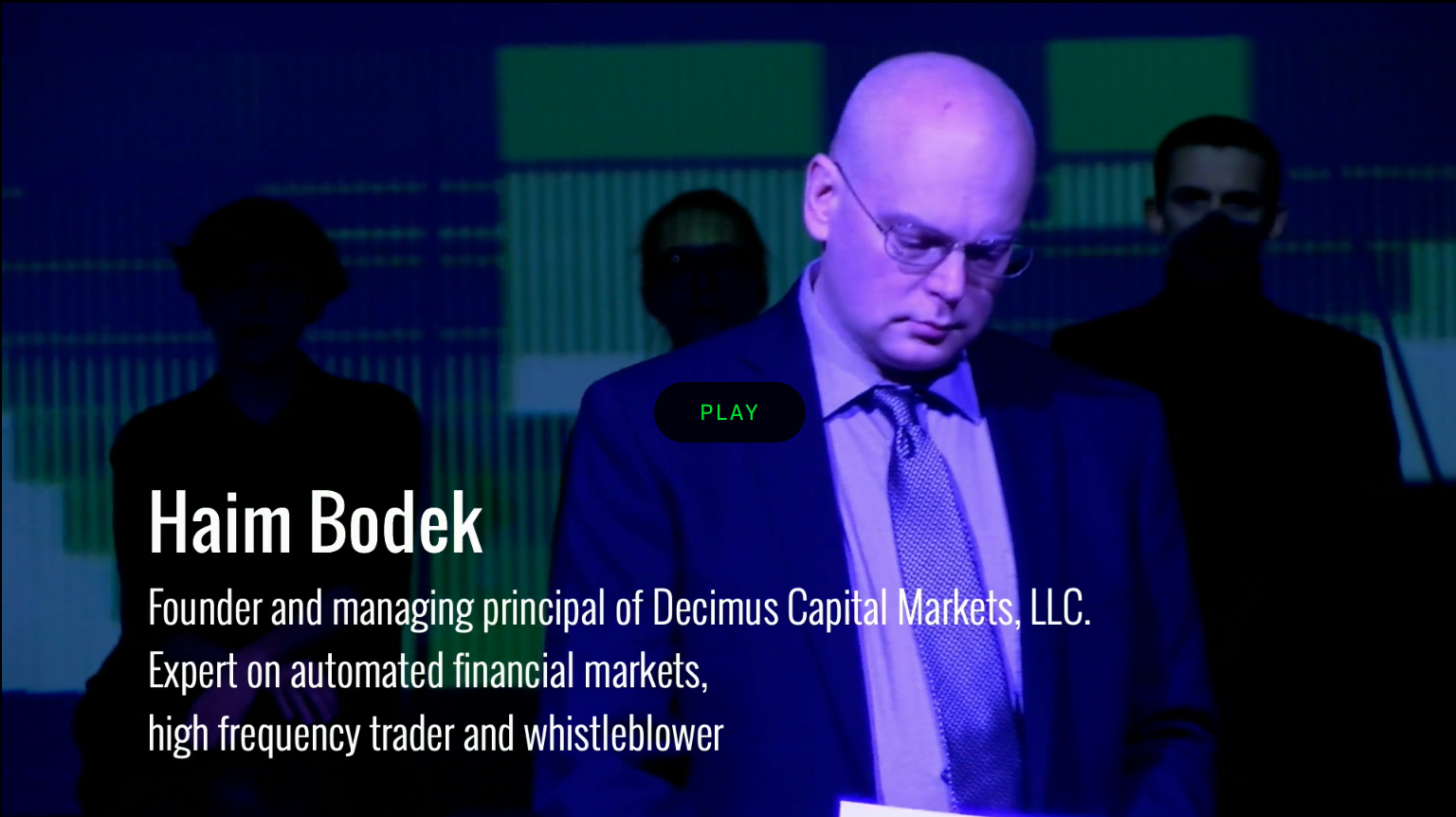
|
|
27’07”
|
“The social spirit of speculation”
On the speculative technologies, speculative imagination, speculative intimacies, populism, and counter-speculation as a potentially emancipatory practice of speculative politics, see Speculative Communities. Living with Uncertainty in a Financialized World by sociologist Aris Komporozos-Athanasiou (University of Chicago Press, 2022).
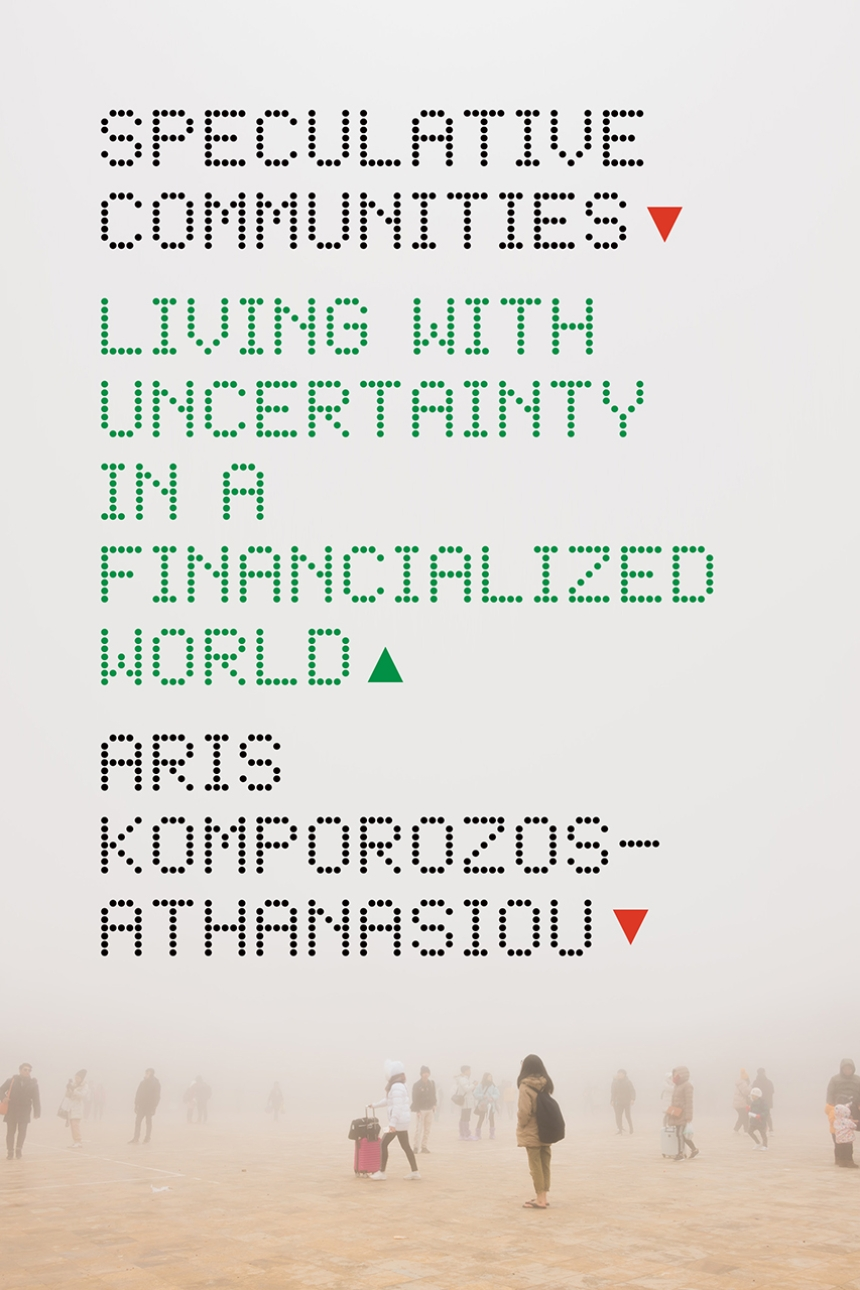
|
|
27’34”
|
“Teslaism is a 3rd person racing musical game…”
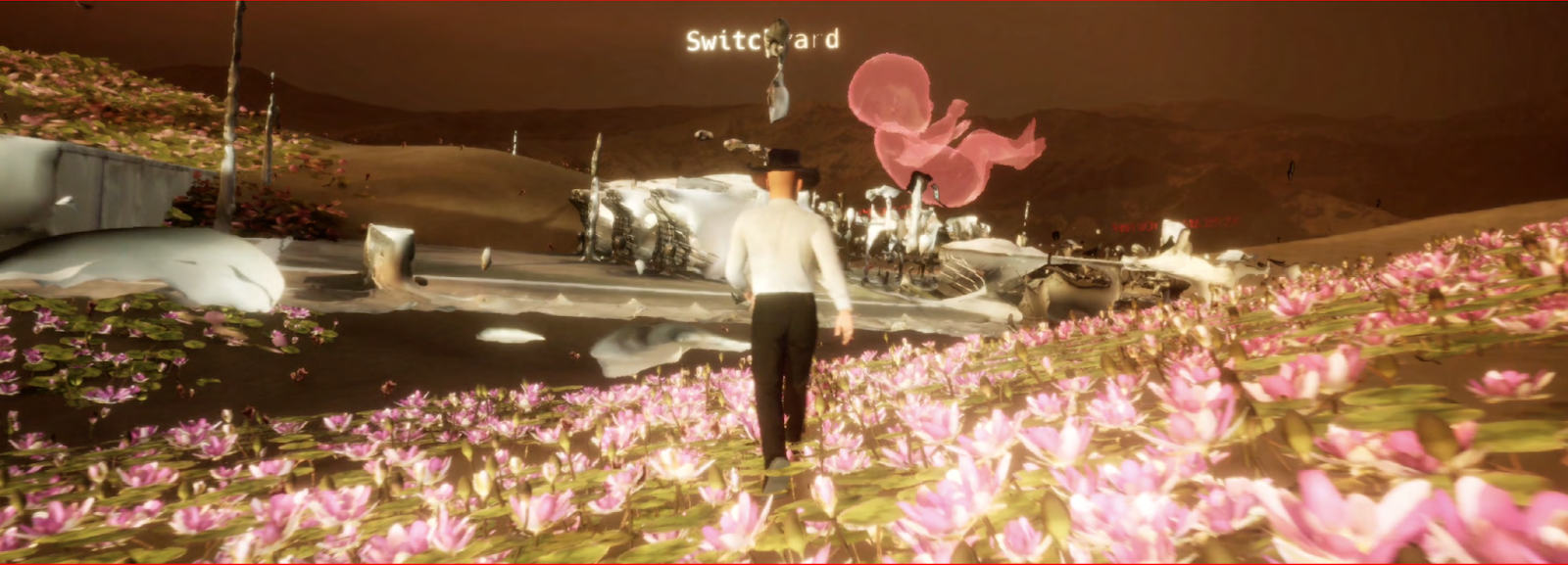 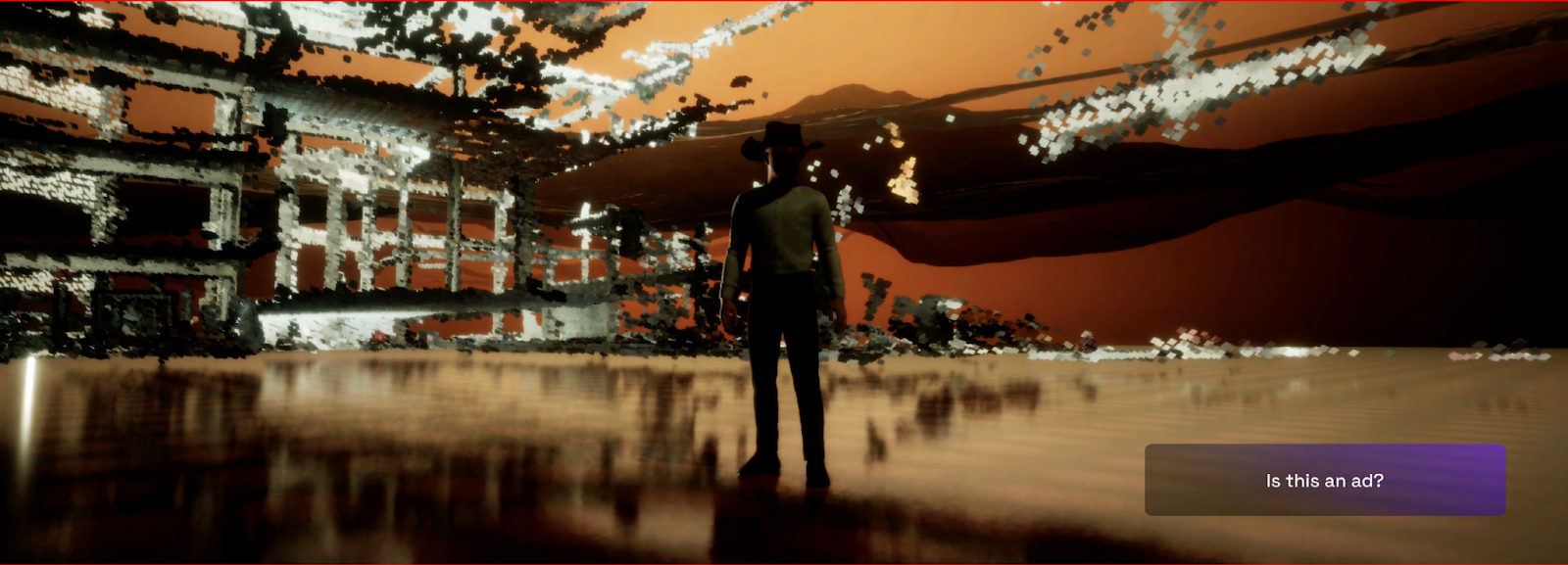
Stills from Teslaism: Economics After the End of the End of the Future
Teslaism: Economics After the End of the End of the Future is a 2022 project by Bahar Noorizadeh, commissioned for Tresor 31: Techno, Berlin, and the Great Freedom, an exhibition reflecting on three decades of musical evolution, social change and city development from Berlin to Detroit, told through the lens of Techno’s history (2022).

Tresor 31st Anniversary, Kraftwerk Berlin, photo by Helge Mundt
|
|
33’45”
|
“Weird economies is a multi-authored socially-connected platform”
Weird Economies online headquarters are located at https://weirdeconomies.com/
For more than a few notes for this episode I have used Weird Economies contributions and glossary. Check it out!
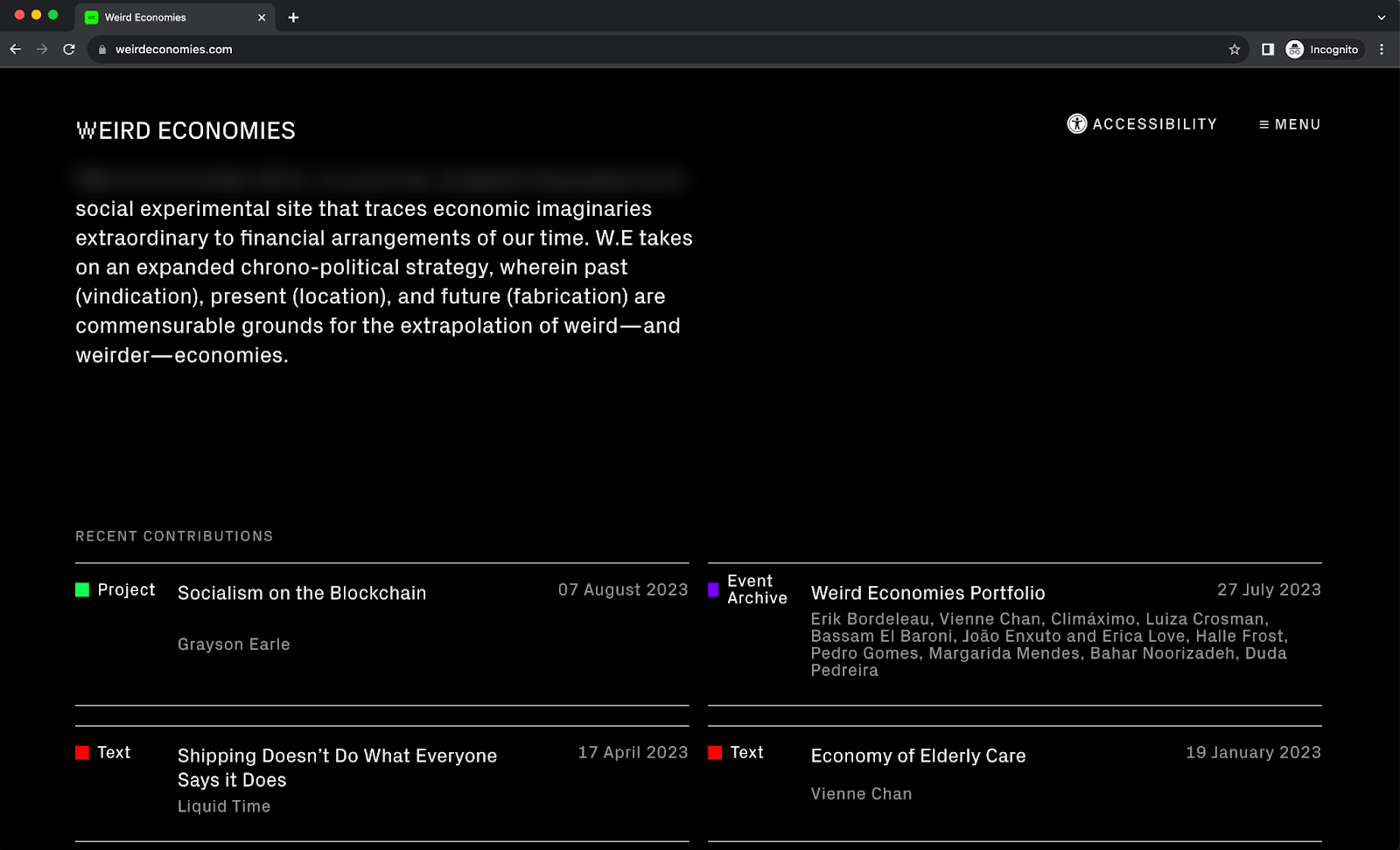

|
|
34’44”
|
“The Cosmo-Financial study group”
For more information on Erik Bordeleau and the Cosmo-Financial study group: https://ifilnova.pt/en/people/erik-bordeleau/
https://weirdeconomies.com/stakeholders/cosmo-financial-study-group
https://ifilnova.pt/en/events/99-theses-on-the-revaluation-of-value/
|
| |
|
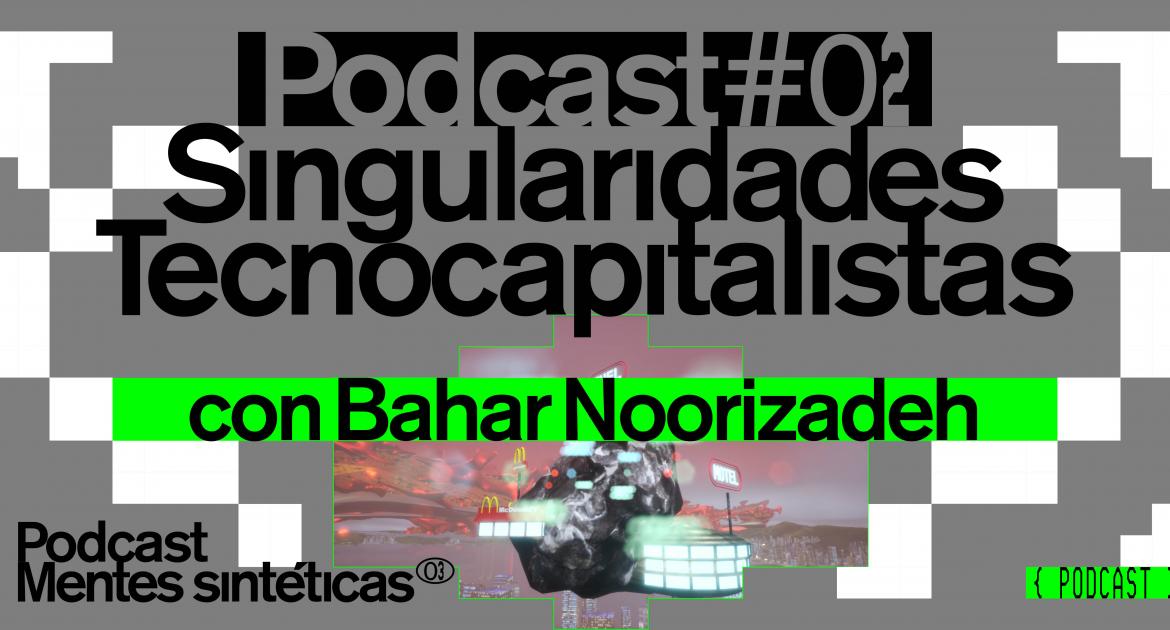



 Medialab-Matadero Madrid
Medialab-Matadero Madrid